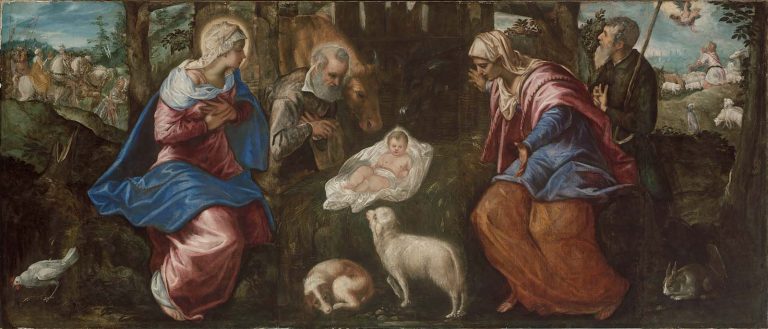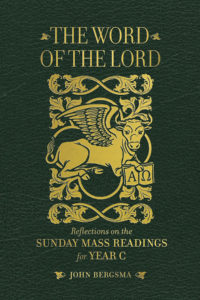By John Bergsma
John Bergsma is Professor of Theology at the Franciscan University of Steubenville. A former Protestant pastor, Dr. Bergsma has authored several books on Scripture and the Catholic faith, including The Word of the Lord series.

Over a twenty-four-hour period, there are four Masses celebrated by the Church: the Vigil of Christmas, Midnight Mass, Mass at Dawn, and Christmas Day Mass. The readings for all four are so beautiful, it is like one continual spiritual feast, a veritable gorging on Scripture.
The texts for this feast day include some of the most pivotal in all of Scripture, and there is no end to the comments that could be made on each.
The Gospel reading on Christmas Eve, the genealogy of Jesus, is tremendously rich, and there is more here than I can adequately cover in this space. Hopefully everyone will read the full reading rather than the shorter option, which skips the genealogy. The genealogy is one of the most interesting aspects of this reading, so it would be a shame to skip it.
Matthew begins the New Testament with “The book of the genealogy of Jesus Christ, the son of David, the son of Abraham.” In this way, Matthew associates Jesus with the fulfillment of promises made to three great patriarchs: Adam, David, and Abraham.
The phrase “The book of the genealogy of” links Jesus to Adam, because the only other occurrence of this phrase in Scripture is in Genesis 5:1, which reads “This is the book of the genealogy of Adam” (NKJV). In this way, Matthew presents us with Jesus as a New Adam, a new father and founder of the human race, a new sinless man and firstborn son of God the Father; a prophet, priest, and king of the cosmos.
Then, by calling Jesus “son of David” and “son of Abraham” as titles, Matthew indicates that Jesus is not merely a descendant of these men, but the particular descendant through whom the covenant promises made to them will be fulfilled. All Jews were sons of Abraham (Matt 3:9), and probably everyone in Nazareth was a descendant of the House of David. But Jesus was the seed. To Abraham God promised “through your seed (i.e., descendant) all the nations of the earth will be blessed” (Gen 22:18, my translation), and to David he promised, “I will raise up your seed after you, who shall come forth from your body, and I will establish his kingdom. He shall build a house for my name, and I will establish the throne of his kingdom forever” (2 Sam 7:12–13, my translation).
Matthew then proceeds to give Jesus’s genealogy. Today we tend to regard genealogies as boring, which is part of the larger misanthropic, family-hating cultural movement in the modern West, in which family and everything pertaining to it—marriage, motherhood, fatherhood, bearing children, etc.—are subject to scorn, criticism, and redefinition. But genealogies were of great importance in Jesus’s day, when controversy surrounded both the kingship and high priesthood, since neither the king (Herod) nor the high priests (descendants of the Maccabees) had the correct genealogies to serve in their offices. Herod, in particular, was only half Jewish and had no connection to the line of David, although he made a claim to have Davidic blood (which absolutely no one believed). This is one of the reasons Herod was so paranoid about threats to his reign (see Matt 2:13–18): he knew that the populace did not consider him legitimate. In fact, we know from the historian Josephus that Herod grew gradually more insane toward the end of his life, trusting no one and killing off many of his immediate family members out of suspicion.
The following genealogy is broken in to three sets of fourteen, since fourteen is the numerical number of David’s name (D-V-D) in Hebrew (D is the fourth letter and V is the sixth letter of the Hebrew alphabet). Matthew is using literary artistry to emphasize the Davidic descent of Jesus.
Four women are included in the genealogy: Tamar, Rahab, Ruth, and Bathsheba.
The first three of these women were Gentiles, and Bathsheba was married to a Gentile. All of them had checkered personal histories: Tamar seduced her father-in-law, Judah (Gen 38), Rahab was a Canaanite harlot (Josh 2), Ruth attempted to seduce Boaz (Ruth 3), and Bathsheba was apparently forced into adultery with David (2 Sam 11). All of them were ancestors of Solomon, the greatest king of the Israelite tradition.
Matthew seems to be preparing us for a Son of David who will be criticized for socializing with Gentiles and prostitutes, and who will inaugurate a kingdom which welcomes sinners and all ethnic groups into its membership. Indeed, the inclusion of the Gentiles and sinners into God’s covenant has been foreshadowed already in the Old Testament. Matthew is also probably contrasting the checkered ancestresses of Solomon, the greatest King of Israel and type of the Messiah, with the immaculate purity of the Blessed Virgin. “[T]here is something greater than Solomon here” (Matt 12:42). Later, Jesus will be visited by wise men from the East when he is still an infant, outdoing Solomon, who was not visited by wise men from the East until he was at the height of his career (1 Kgs 4:29–34).
Matthew’s intention in the genealogy seems to be to establish Jesus’s legal right to the throne more than his biological descent. I say that because, at the end of the genealogy, Matthew makes clear that there was no biological relationship between St. Joseph and Jesus. Nonetheless, Jesus was Joseph’s legal son and heir to the throne. This was common procedure in the ancient world: for example, Augustus Caesar was Julius Caesar’s legal son (by adoption), but biologically he was a nephew. Nonetheless, Roman genealogies list Augustus as the son of Julius. In my view, the biological genealogy of Jesus is given in Luke 3 (through Mary’s father [thus Joseph’s father-in-law] Heli [St. Joachim of tradition]). Joseph is called the “son” of Heli/Joachim in Luke 3 because the husband of an only daughter became the legal son and heir of his father-in-law, and inherited his father-in-law’s estate.
You Might Also Like
The Catholic Lectionary guides us through the liturgical year, presenting Old and New Testament readings that together reveal God’s unfolding plan for our salvation. In The Word of the Lord series, biblical scholar Dr. John Bergsma provides commentary alongside each Sunday’s readings.
The Word of the Lord: Reflections on the Sunday Mass Readings for Year C
The Word of the Lord: Reflections on the Mass Readings for Solemnities and Feasts

